This document discusses OPL best practices and includes the following sections: calling OPL from outside programs like Excel, Matlab, Python, and R; modeling tricks within OPL like using piecewise linear functions and decision variables as indices; practical tricks within OPL like displaying 2D objects, exporting to CSV files, and calculating the Cartesian product; decomposition techniques; and specific examples. The document is intended as a supplement to documentation and trainings, and the author welcomes feedback to improve it. Examples referenced are available on the author's LinkedIn page.
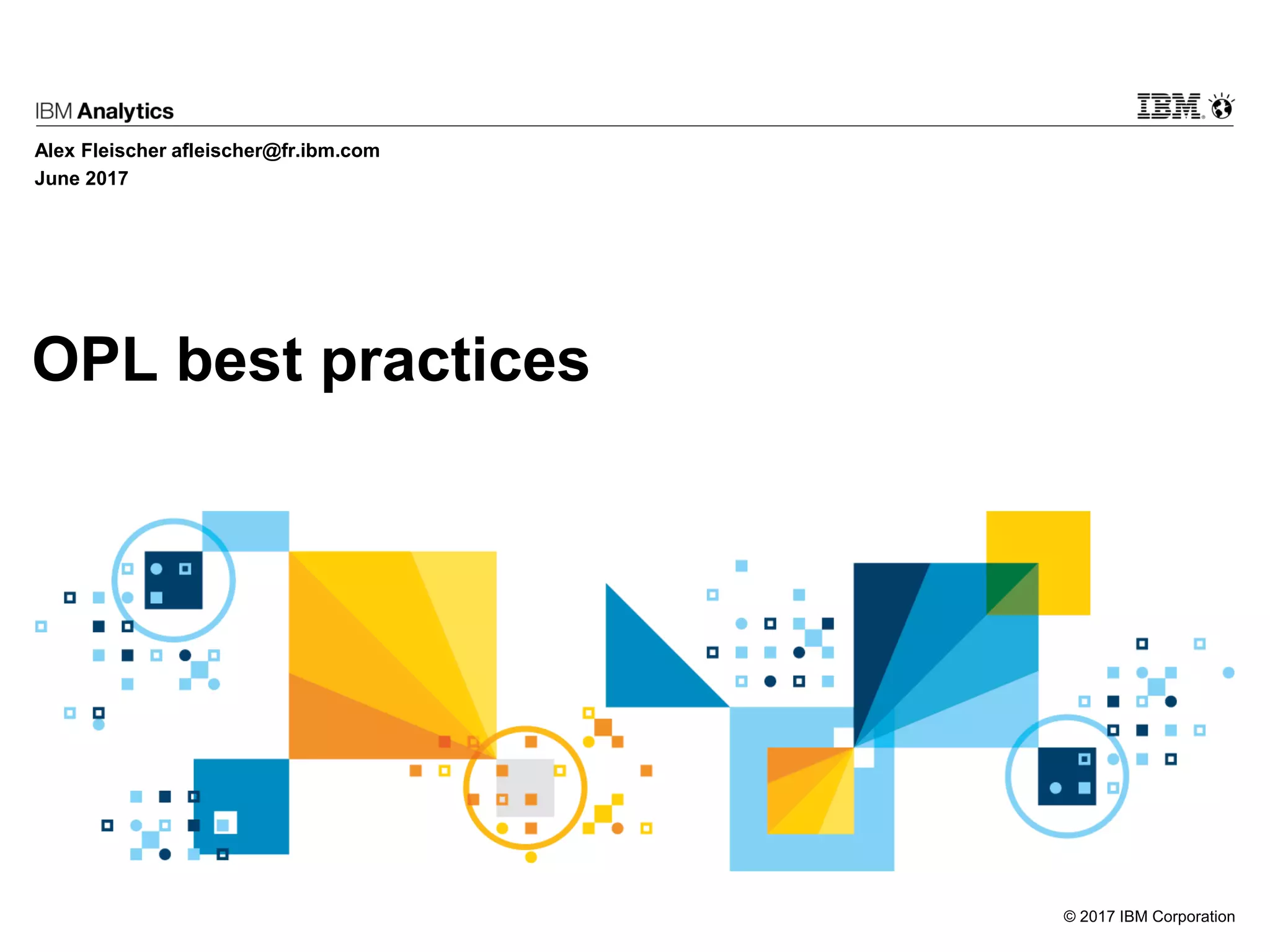
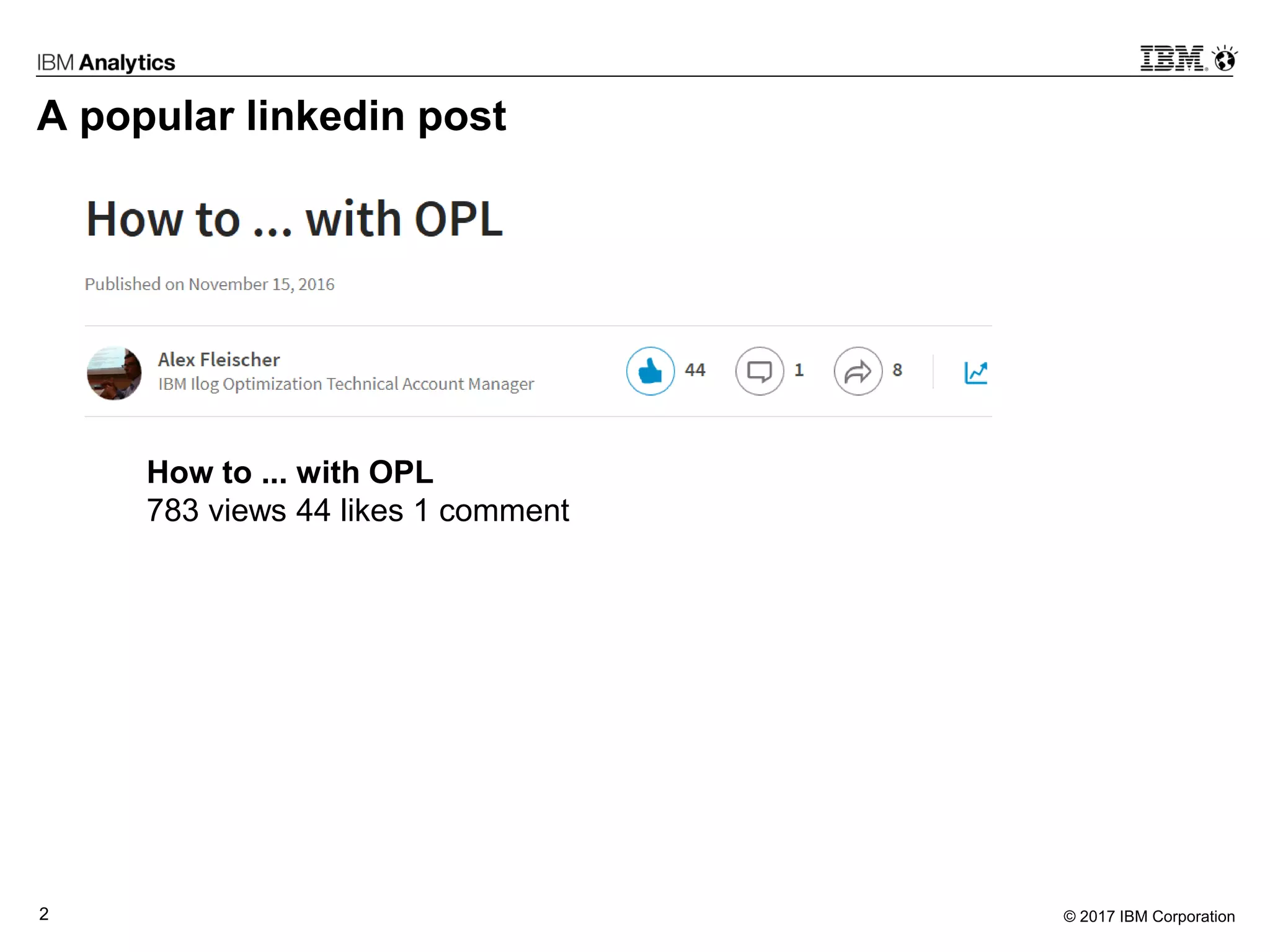
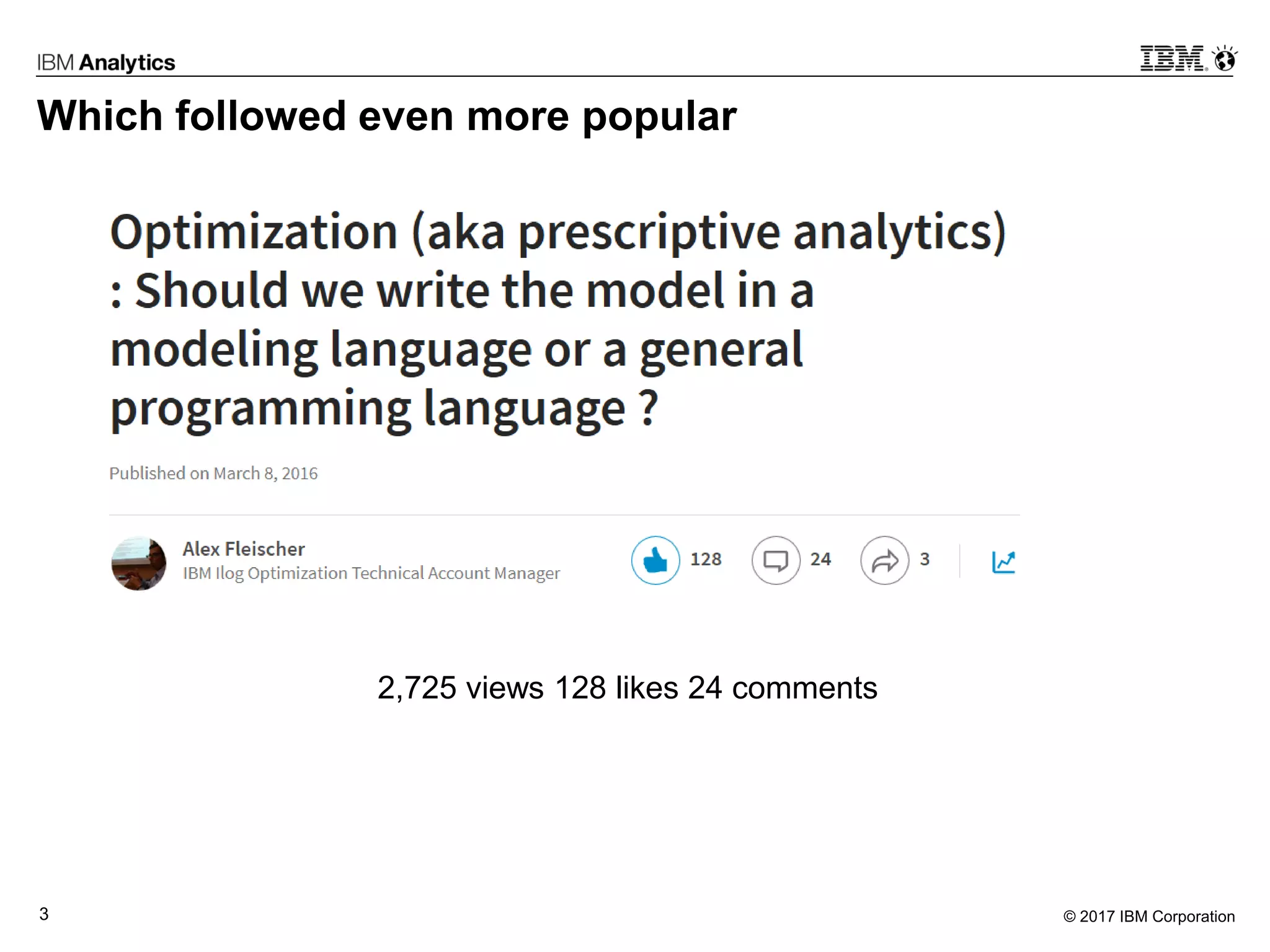
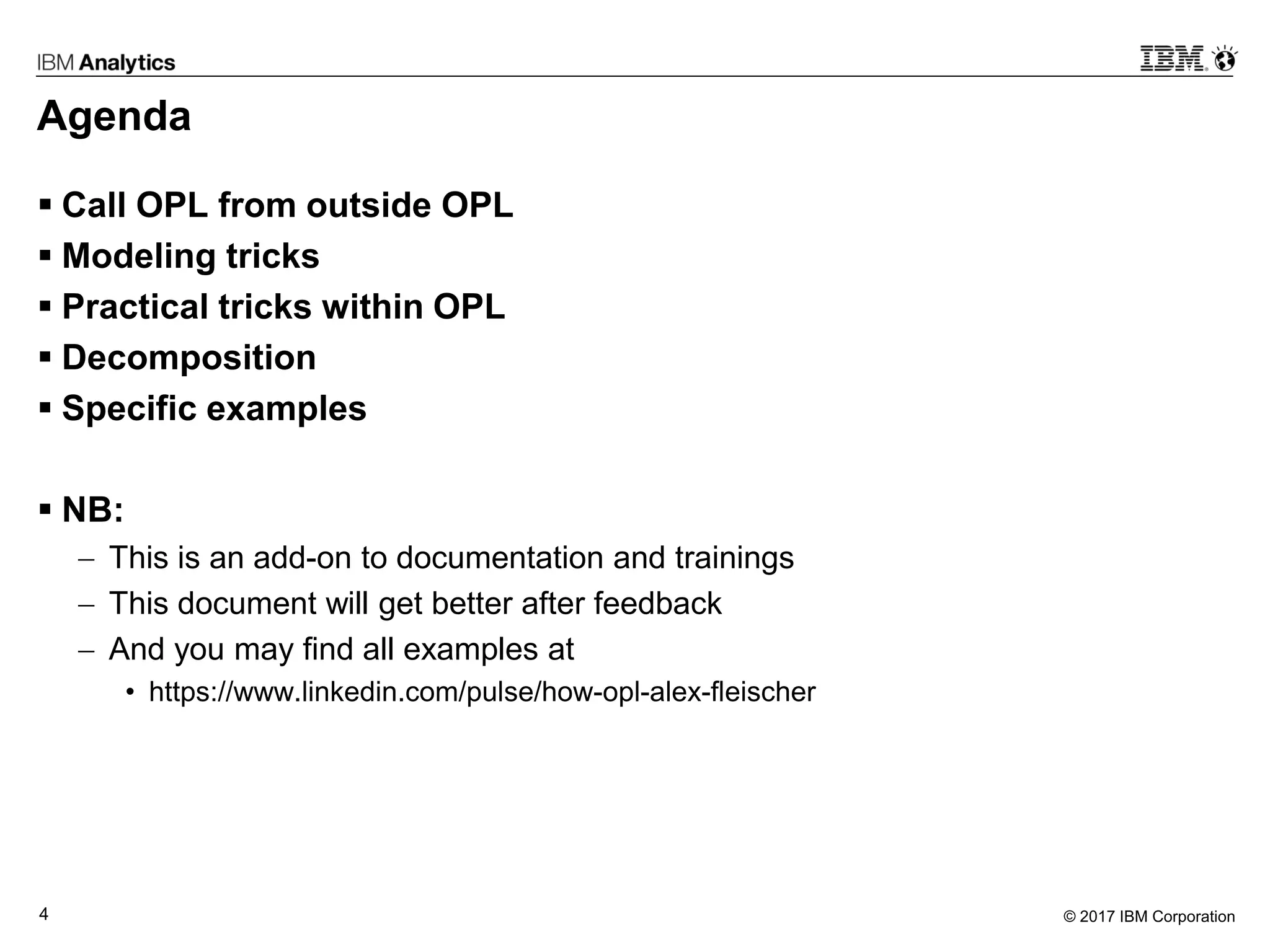
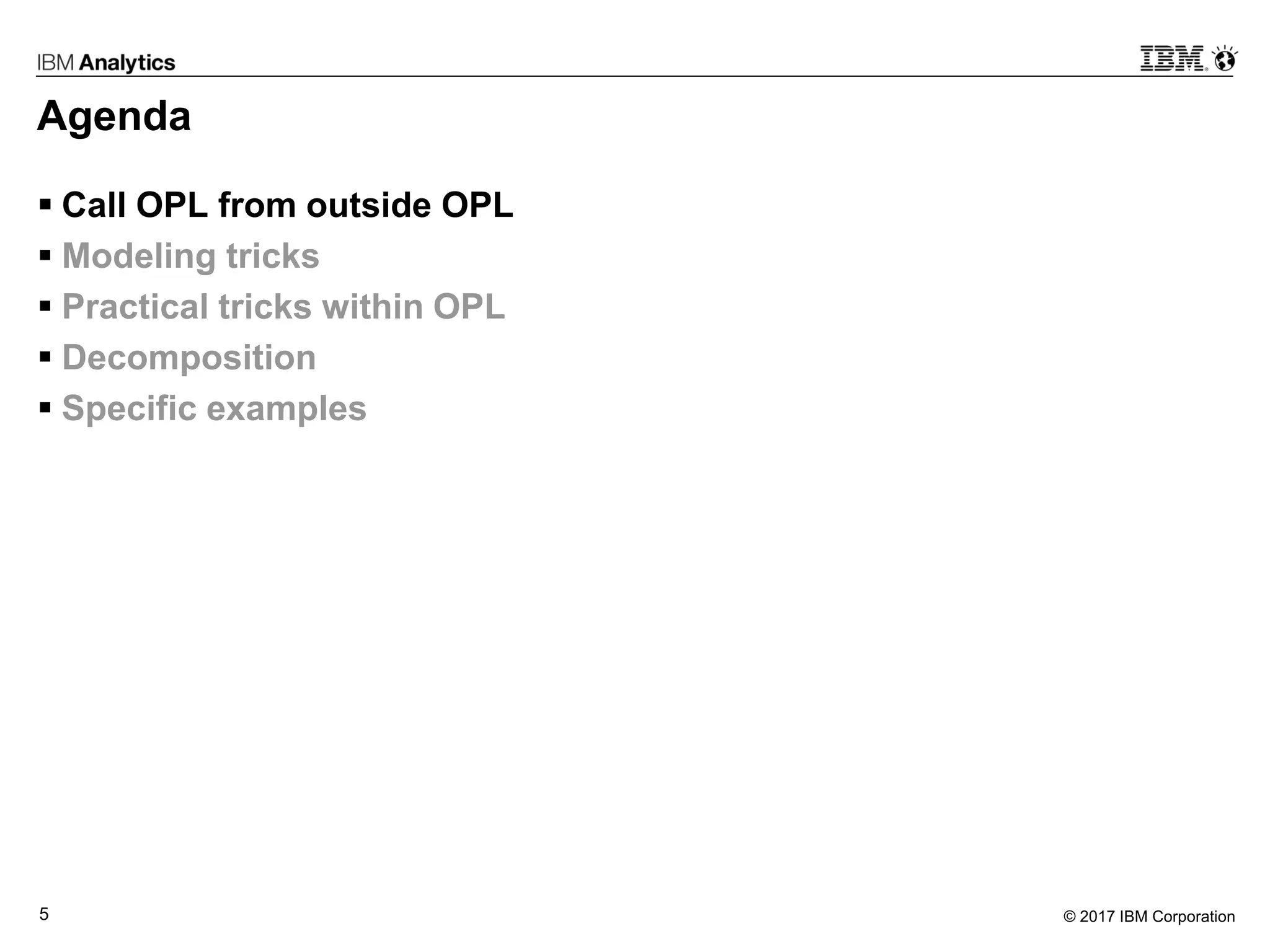
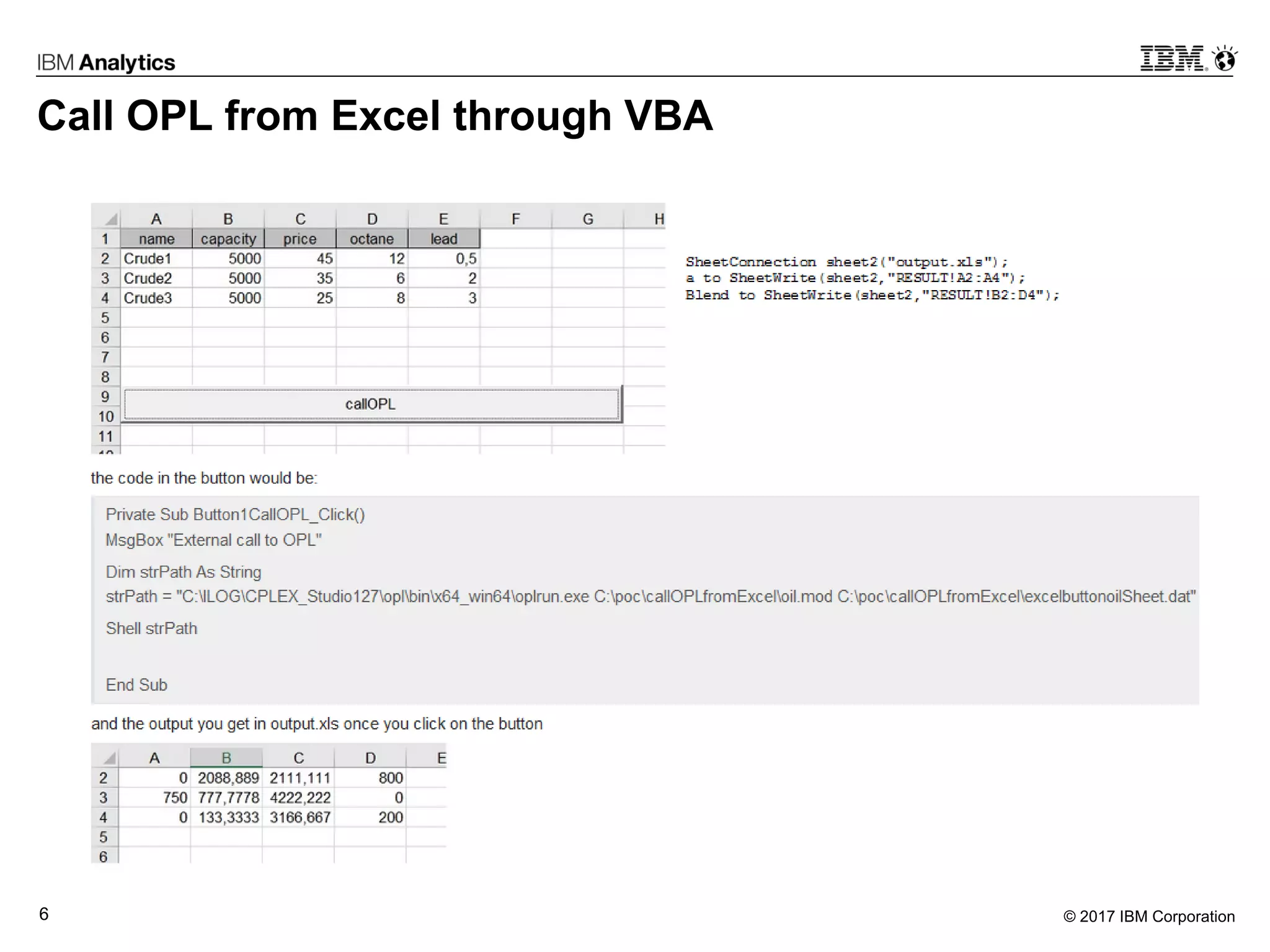
![© 2017 IBM Corporation7
Call OPL from Matlab
The main idea is to use "system" in Matlab
>> command = 'oplrun model.mod data.dat';
>> [status, cmdout] = system(command);
status is the return code given by oplrun.](https://image.slidesharecdn.com/oplbestpractices-170718075121/75/OPL-best-practices-Doing-more-with-less-easier-7-2048.jpg)
![© 2017 IBM Corporation8
Call OPL from Python
import subprocess
dat = open('diet.dat','w')
writedat(dat,'FOODS',FOODS);
writedat(dat,'NUTRIENTS',NUTRIENTS);
writedat(dat,'FOOD_NUTRIENTS',FOOD_NUTRIENTS);
dat.close()
subprocess.check_call(
["C:/ILOG/CPLEXStudio1263/opl/bin/x64_win64/oplrun", "diet.mod", "diet.dat"])
](https://image.slidesharecdn.com/oplbestpractices-170718075121/75/OPL-best-practices-Doing-more-with-less-easier-8-2048.jpg)
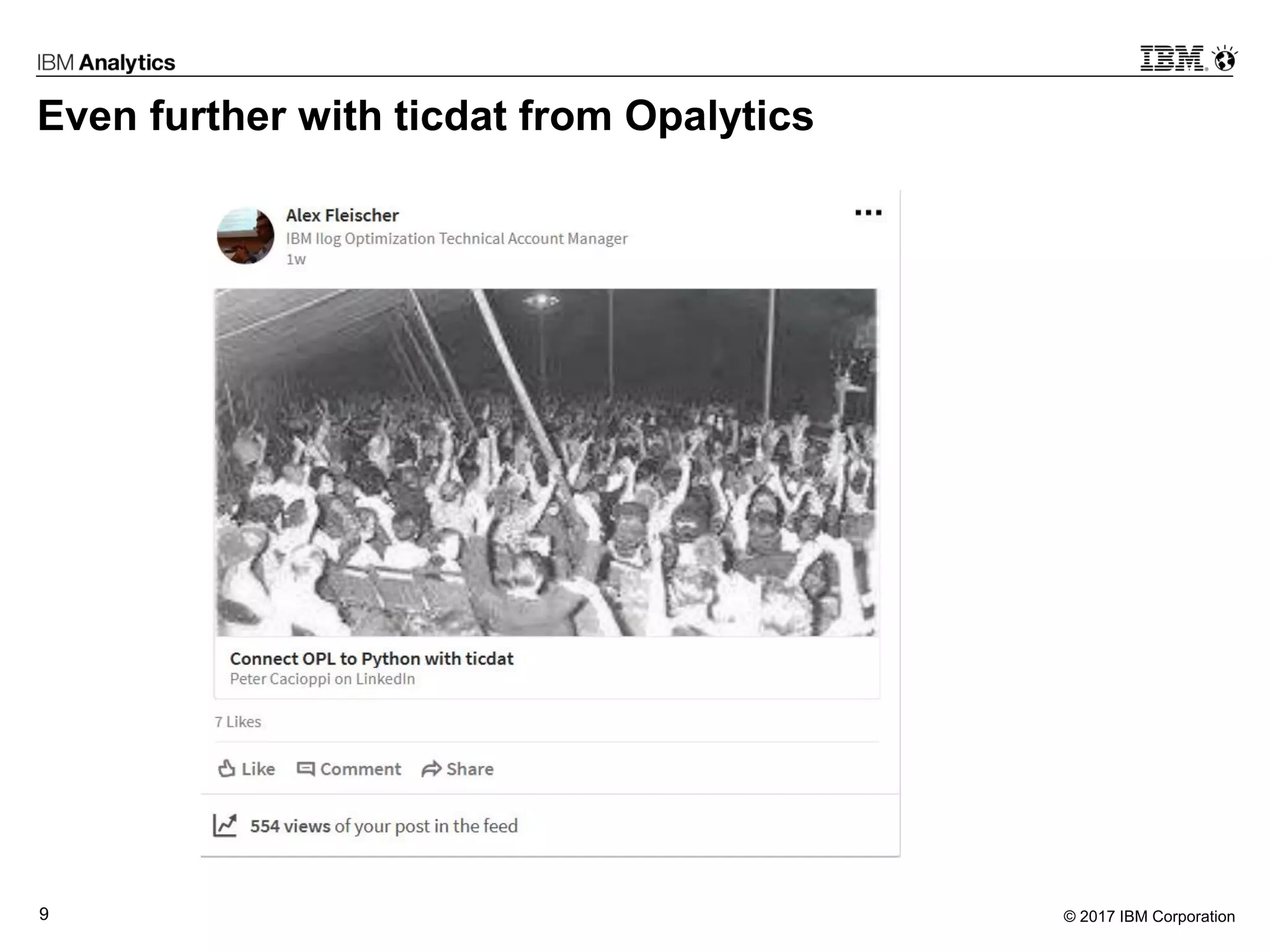
![© 2017 IBM Corporation10
Call OPL from R
Diet.r is
system("oplrun diet.mod diet.dat")
To run this example, simply do
Rscript.exe diet.r
And in Rscript.exe diet.r you ll get
quantity = [0 2.1552 0 0 0 10 1.8312 0 0.9297]
cost = 2.690409172
amount = [2000 800 11.278 8518.4 25 256.81 51.174]](https://image.slidesharecdn.com/oplbestpractices-170718075121/75/OPL-best-practices-Doing-more-with-less-easier-10-2048.jpg)
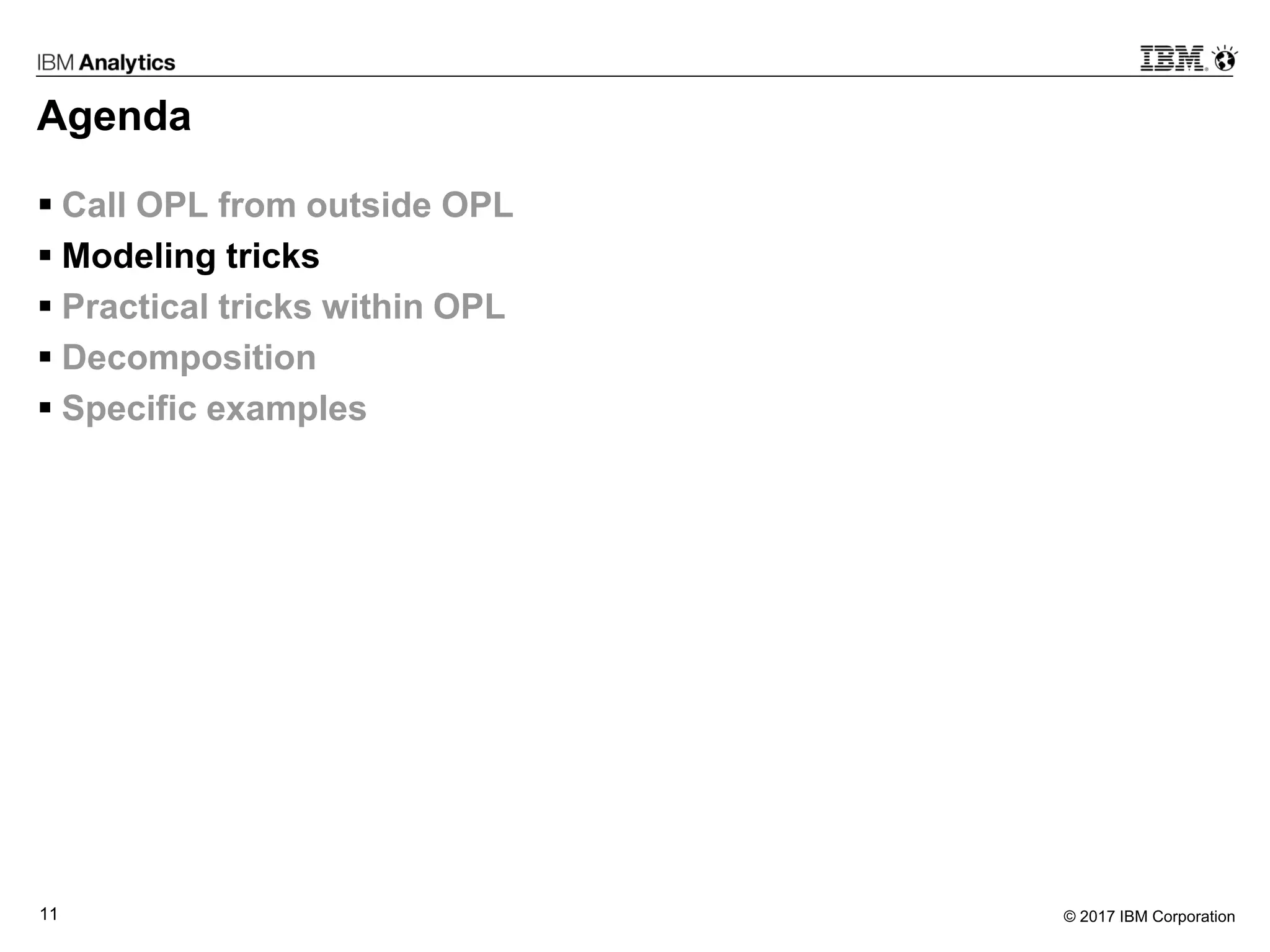
![© 2017 IBM Corporation12
How to describe a piecewise linear function with breakpoints rather than slopes
float firstSlope=0.5;
float lastSlope=2.0;
tuple breakpoint // y=f(x)
{
key float x;
float y;
}
sorted { breakpoint } breakpoints={<0,0>,<1,1>,<2,4>};
float slopesBeforeBreakpoint[b in breakpoints]=
(b.x==first(breakpoints).x)
?firstSlope
:(b.y-prev(breakpoints,b).y)/(b.x-prev(breakpoints,b).x);
pwlFunction f=piecewise(b in breakpoints)
{ slopesBeforeBreakpoint[b]->b.x; lastSlope } (first(breakpoints).x, first(breakpoints).y);
assert forall(b in breakpoints) f(b.x)==b.y;](https://image.slidesharecdn.com/oplbestpractices-170718075121/75/OPL-best-practices-Doing-more-with-less-easier-12-2048.jpg)
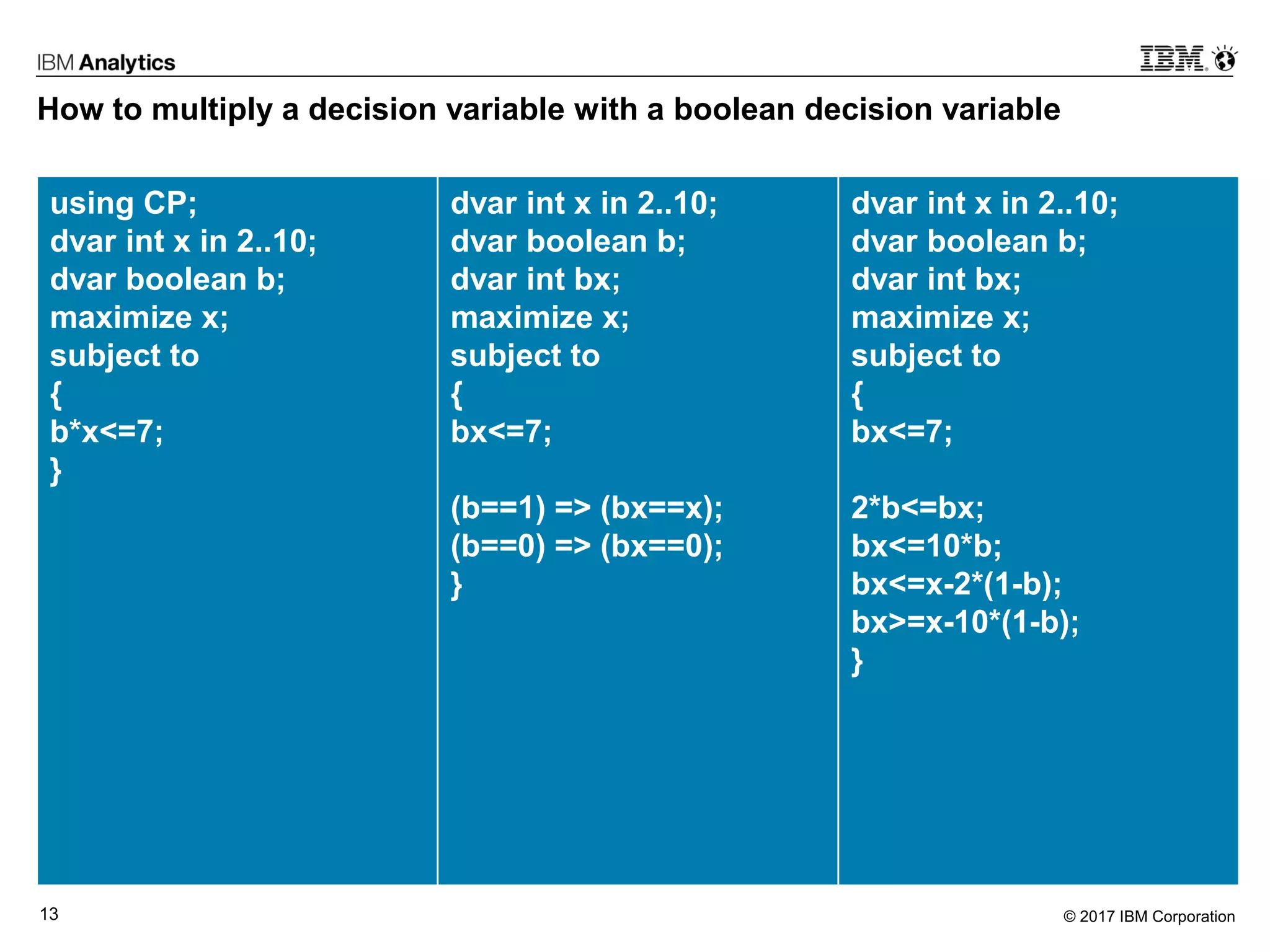
![© 2017 IBM Corporation14
How to use a decision variable as an index in an array with CPLEX
using CP;
range r=1..5;
float value[r]=[2,3,4.5,1,0];
dvar int i in 1..5;
maximize value[i];
subject to
{
}
execute
{
writeln("i=",i);
}
range r=1..5;
float value[r]=[2,3,4.5,1,0];
dvar int i in 1..5;
maximize sum(k in r) value[k]*(k==i);
subject to
{
}
execute
{
writeln("i=",i);
}](https://image.slidesharecdn.com/oplbestpractices-170718075121/75/OPL-best-practices-Doing-more-with-less-easier-14-2048.jpg)
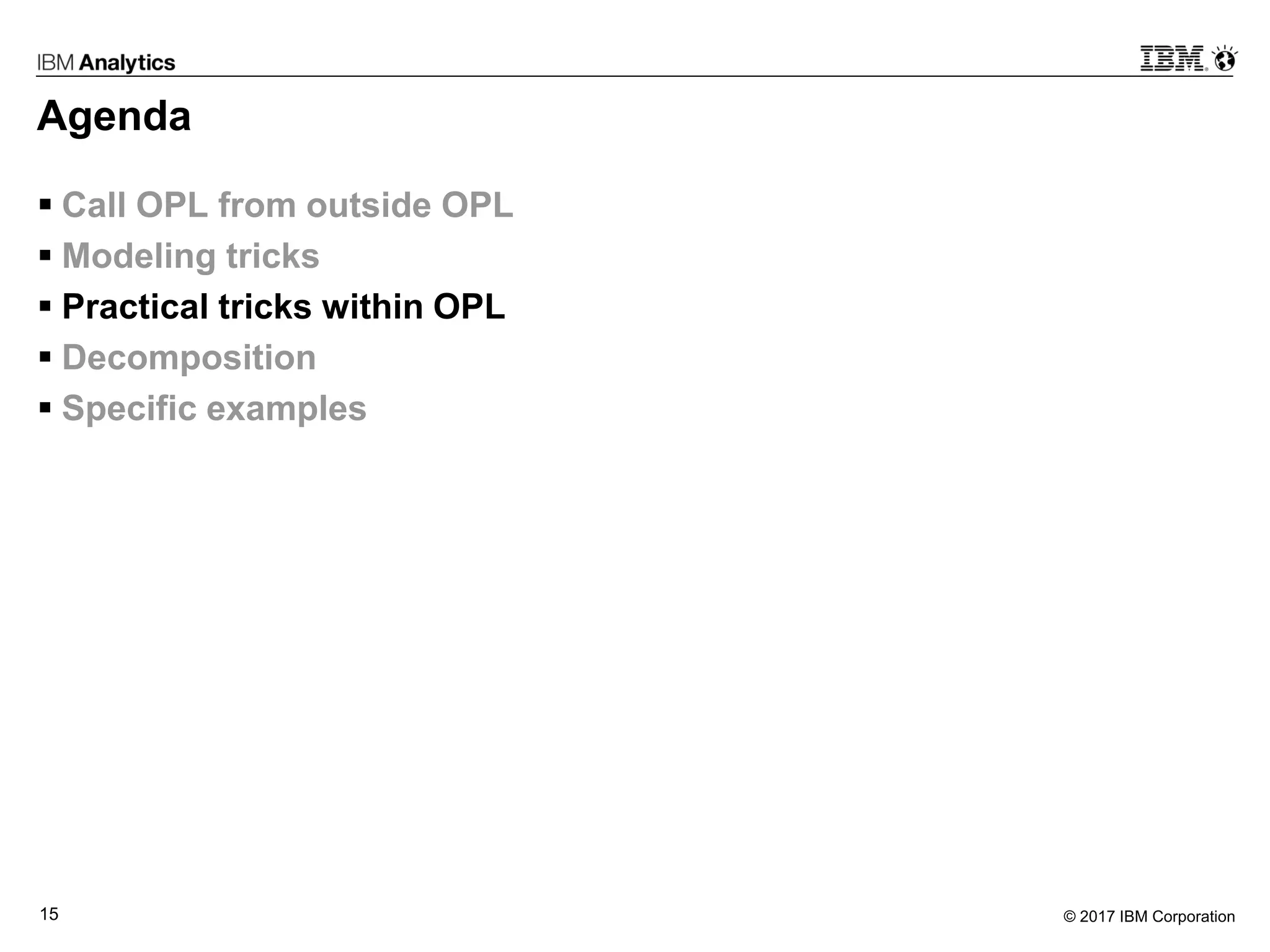
![© 2017 IBM Corporation16
Displaying 2 dimensions objects in the OPL IDE
tuple sequence_like {
int start;
int end;
string label;
int type;
};
{sequence_like} array2[i in 1..n] = {<j-1,j," ",Life[i][j]> | j in 1..n};](https://image.slidesharecdn.com/oplbestpractices-170718075121/75/OPL-best-practices-Doing-more-with-less-easier-16-2048.jpg)
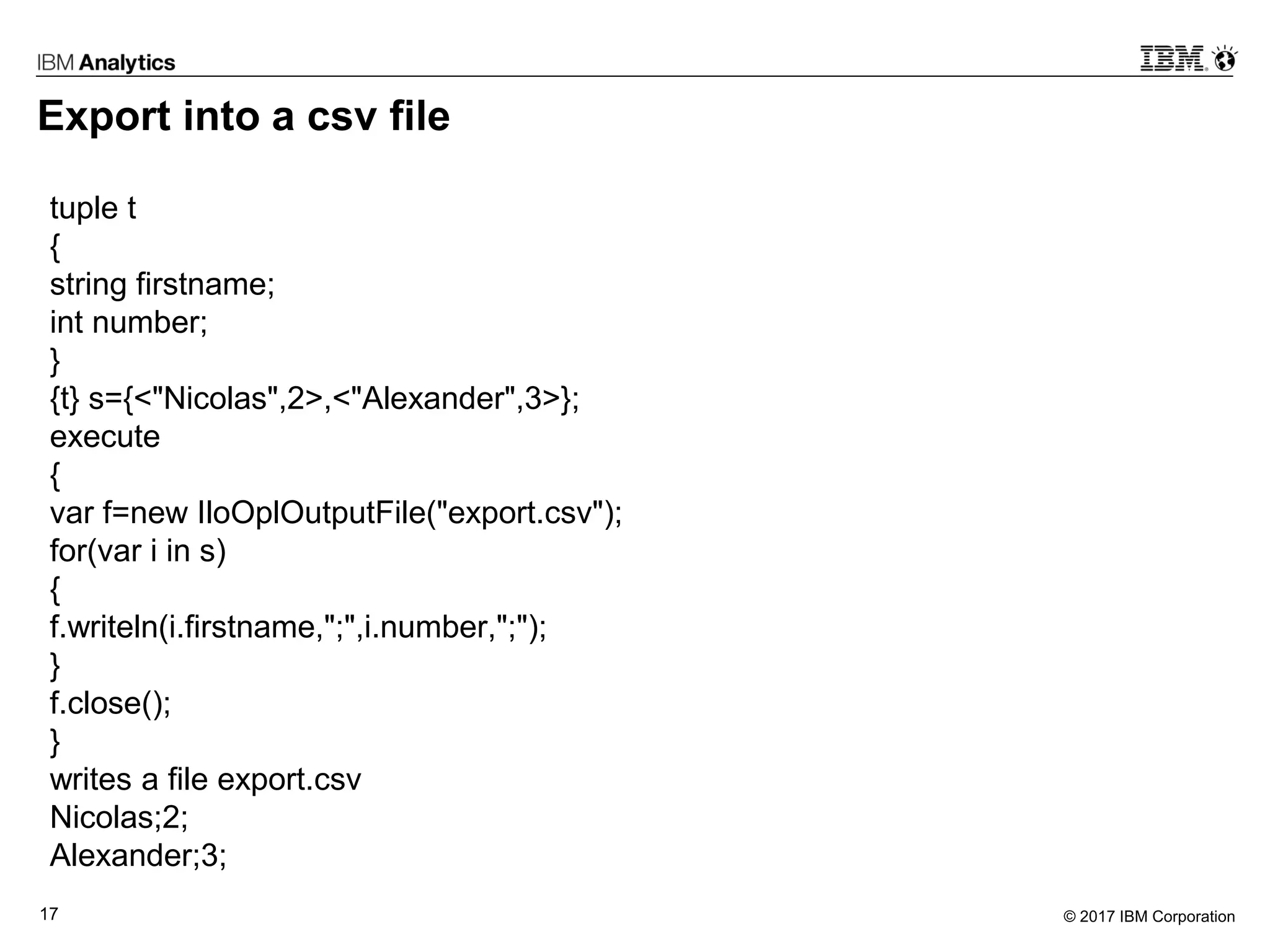
![© 2017 IBM Corporation18
Import from csv file
Suppose you have this export.cvs file
Nicolas;2;
Alexander;3;
Then you could write
tuple t
{
string firstname;
int number;
}
{t} s={};
execute
{
var f=new IloOplInputFile("export.csv");
while (!f.eof)
{
var str=f.readline();
//writeln(str);
var ar=str.split(";");
if (ar.length==3) s.add(ar[0],Opl.intValue(ar[1]));
}
f.close();
}
execute
{
writeln(s);
}
which will read the csv file and compute the tuple set s:
{<"Nicolas" 2> <"Alexander" 3>}](https://image.slidesharecdn.com/oplbestpractices-170718075121/75/OPL-best-practices-Doing-more-with-less-easier-18-2048.jpg)
![© 2017 IBM Corporation19
Cartesian product in OPL
tuple Tset {
{string} members;
}
{Tset} setOfTuples = {<{"1","2"}>,<{"4","5","6"}>,<{"8","9"}>};
int dimresult=prod(i in 1..card(setOfTuples)) card(item(setOfTuples,i-
1).members);
{string} setPool[i in 1..dimresult]={}; // pool of sets
{string} options[i in 1..card(setOfTuples)]=(item(setOfTuples,i-
1).members);
{Tset} result={};
//For this particular example, the function needs to return:
//{<{1,4,8}>,<{1,4,9}>,<{1,5,8}>,<{1,5,9}>,<{1,6,8}>,<{1,6,9}>,<{2,4,8}>,<{2
,4,9}>,<{2,5,8}>,<{2,5,9}>,<{2,6,8}>,<{2,6,9}>}
execute
{
options;
function nextone(ndimension,sizes,e)
{
e[1]++;
for(j=1;j<=ndimension;j++)
{
if (e[j]>= sizes[j] )
{
e[j]=0;
e[j+1]++;
}
}
}
var dim=setOfTuples.size;
writeln("dim=",dim);
var sizes=new Array(dim);
var e=new Array(dim);
var dimresult=1;
for(var i=1;i<=dim;i++)
{
sizes[i]=Opl.item(setOfTuples,i-1).members.size;
e[i]=0;
dimresult*=sizes[i];
writeln(sizes[i]);
}
for(var i=1;i<=dimresult;i++)
{
for(var j=1;j<=dim;j++)
{
write(e[j]," ");
setPool[i].add(Opl.item(options[j],e[j]));
}
writeln();
nextone(dim,sizes,e);
result.add(setPool[i]);
}
writeln(result);
}](https://image.slidesharecdn.com/oplbestpractices-170718075121/75/OPL-best-practices-Doing-more-with-less-easier-19-2048.jpg)
![© 2017 IBM Corporation20
Powerset in OPL
{string} s={"A","B","C","D"};
range r=1.. ftoi(pow(2,card(s)));
{string} s2 [k in r] = {i | i in s: ((k div (ftoi(pow(2,(ord(s,i))))) mod 2) == 1)};
execute
{
writeln(s2);
}](https://image.slidesharecdn.com/oplbestpractices-170718075121/75/OPL-best-practices-Doing-more-with-less-easier-20-2048.jpg)
![© 2017 IBM Corporation21
How to evaluate CPLEX random seed variability in OPL
int n=30; // number of random seeds
int d[1..n]; // duration
int o[1..n]; // objective
int iter[1..n]; // iterations
// start of the model we want to test
int Fixed = 100;
int NbWarehouses = 50;
int NbStores = 200;
assert( NbStores > NbWarehouses );
range Warehouses = 1..NbWarehouses;
range Stores = 1..NbStores;
int Capacity[w in Warehouses] =
NbStores div NbWarehouses +
w % ( NbStores div NbWarehouses );
int SupplyCost[s in Stores][w in Warehouses] =
1 + ( ( s + 10 * w ) % 100 );
dvar int Open[Warehouses] in 0..1;
dvar float Supply[Stores][Warehouses] in 0..1;
dexpr int TotalFixedCost = sum( w in Warehouses ) Fixed * Open[w];
dexpr float TotalSupplyCost = sum( w in Warehouses, s in Stores
) SupplyCost[s][w] * Supply[s][w];
minimize TotalFixedCost + TotalSupplyCost;
subject to {
forall( s in Stores )
ctStoreHasOneWarehouse:
sum( w in Warehouses )
Supply[s][w] == 1;
forall( w in Warehouses )
ctOpen:
sum( s in Stores )
Supply[s][w] <= Open[w] * Capacity[w];
}
// end of the model we want to test
main {
thisOplModel.generate();
var sum_d=0;
var sum_o=0;;
var sum_iter=0;
writeln("seed objective iteration runtime");
for(var i=1;i<=thisOplModel.n;i++)
{
var opl=new IloOplModel(thisOplModel.modelDefinition);
opl.generate();
cplex.randomseed=i;
var d1=new Date();
cplex.solve();
var d2=new Date();
thisOplModel.d[i]=d2-d1;
sum_d+=d2-d1;
thisOplModel.d[i]=d2-d1;
thisOplModel.o[i]=Opl.ftoi(Opl.round(cplex.getObjValue()));
sum_o+=thisOplModel.o[i];
thisOplModel.iter[i]=cplex.getNiterations();
sum_iter+=thisOplModel.iter[i];
writeln(i," ",thisOplModel.o[i]," ",thisOplModel.iter[i]," ",
thisOplModel.d[i]/1000);
cplex.clearModel();
}
writeln("-----------------------------------------");
writeln("average ",sum_o/thisOplModel.n," ",
sum_iter/thisOplModel.n," ",sum_d/thisOplModel.n/1000);
writeln("std dev ",Opl.standardDeviation(thisOplModel.o)," ",
Opl.standardDeviation(thisOplModel.iter)," ",Opl.standardDeviation(thisO
plModel.d)/1000);
}](https://image.slidesharecdn.com/oplbestpractices-170718075121/75/OPL-best-practices-Doing-more-with-less-easier-21-2048.jpg)
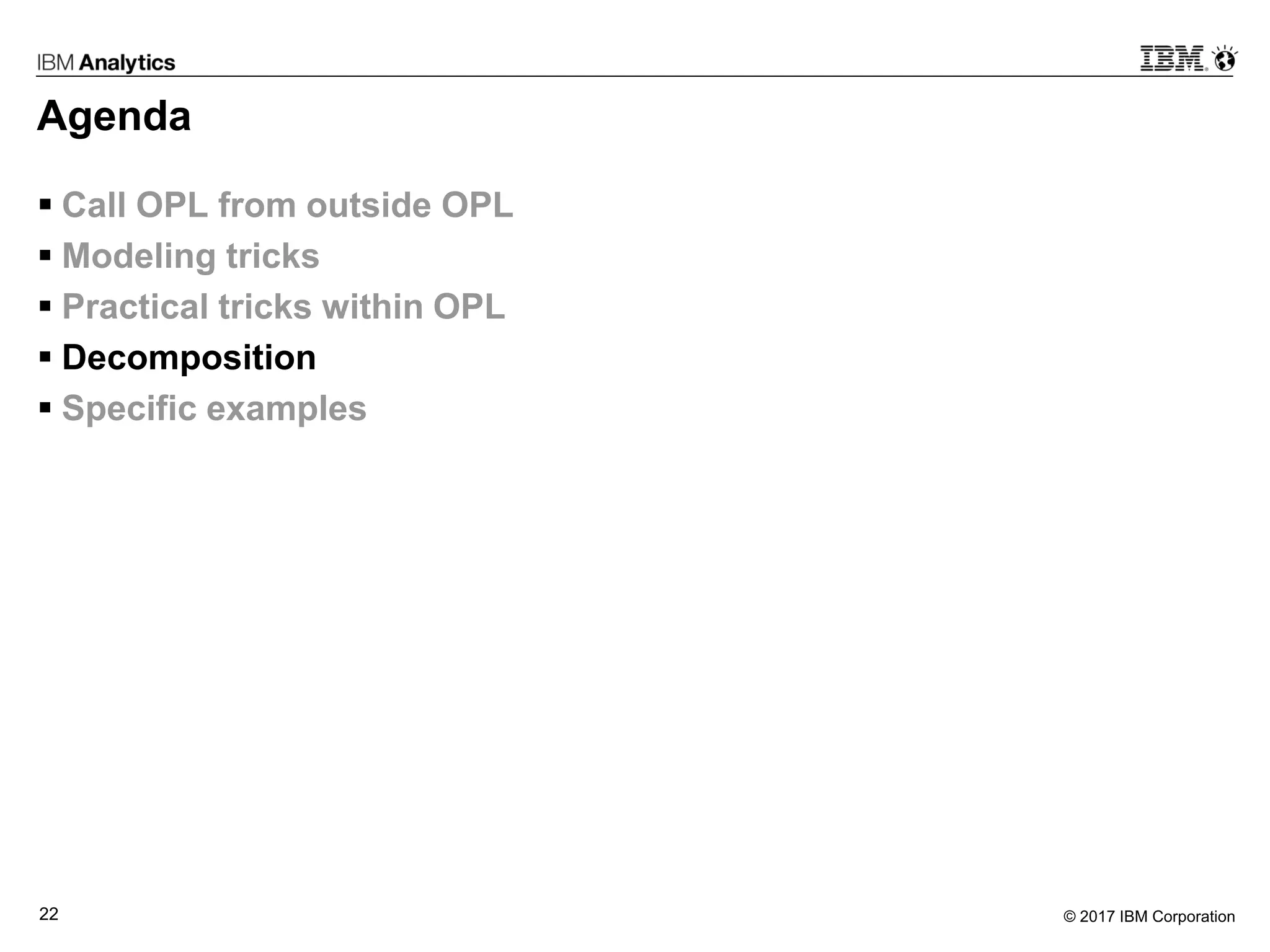
![© 2017 IBM Corporation23
Hybrid CPO and CPLEX
int n=20;
int values[0..(n+2)*(n+2)-1];
main {
var n=20;
var source1 = new IloOplModelSource("lifegameip.mod");
var cplex = new IloCplex();
var def1 = new IloOplModelDefinition(source1);
var source2 = new IloOplModelSource("lifegamecp.mod");
var cp = new IloCP();
var def2 = new IloOplModelDefinition(source2);
var opl1 = new IloOplModel(def1,cplex);
var opl2 = new IloOplModel(def2,cp);
opl1.generate();
opl2.generate();
var objValues=new Array(2*5);
for(var iter=1;iter<=5;iter++)
{
cplex.tilim=10;
cplex.solve();
writeln("cplex objective = ",cplex.getObjValue());
objValues[iter*2-1]=cplex.getObjValue();
cp.param.timelimit=10;
cp.param.SearchType=24;
// Warmstart
var sol=new IloOplCPSolution();
for(var i=0;i<=(n+2)*(n+2)-1;i++) sol.setValue(opl2.x[i],opl1.x[i]);
cp.setStartingPoint(sol);
cp.param.SearchType=24;
//opl2.Obj.LB=cplex.getObjValue();
cp.solve();
writeln("cpo objective =",cp.getObjValue());
objValues[iter*2]=cp.getObjValue();
var vectors = new IloOplCplexVectors();
// We attach the values (defined as data) as starting solution
// for the variables x.
for(var i=0;i<=(n+2)*(n+2)-1;i++) thisOplModel.values[i]=opl2.x[i];
vectors.attach(opl1.x,thisOplModel.values);
vectors.setVectors(cplex);
}
writeln("list of objectives") ;
for(var i=1;i<=10;i++) writeln(objValues[i]);
}](https://image.slidesharecdn.com/oplbestpractices-170718075121/75/OPL-best-practices-Doing-more-with-less-easier-23-2048.jpg)
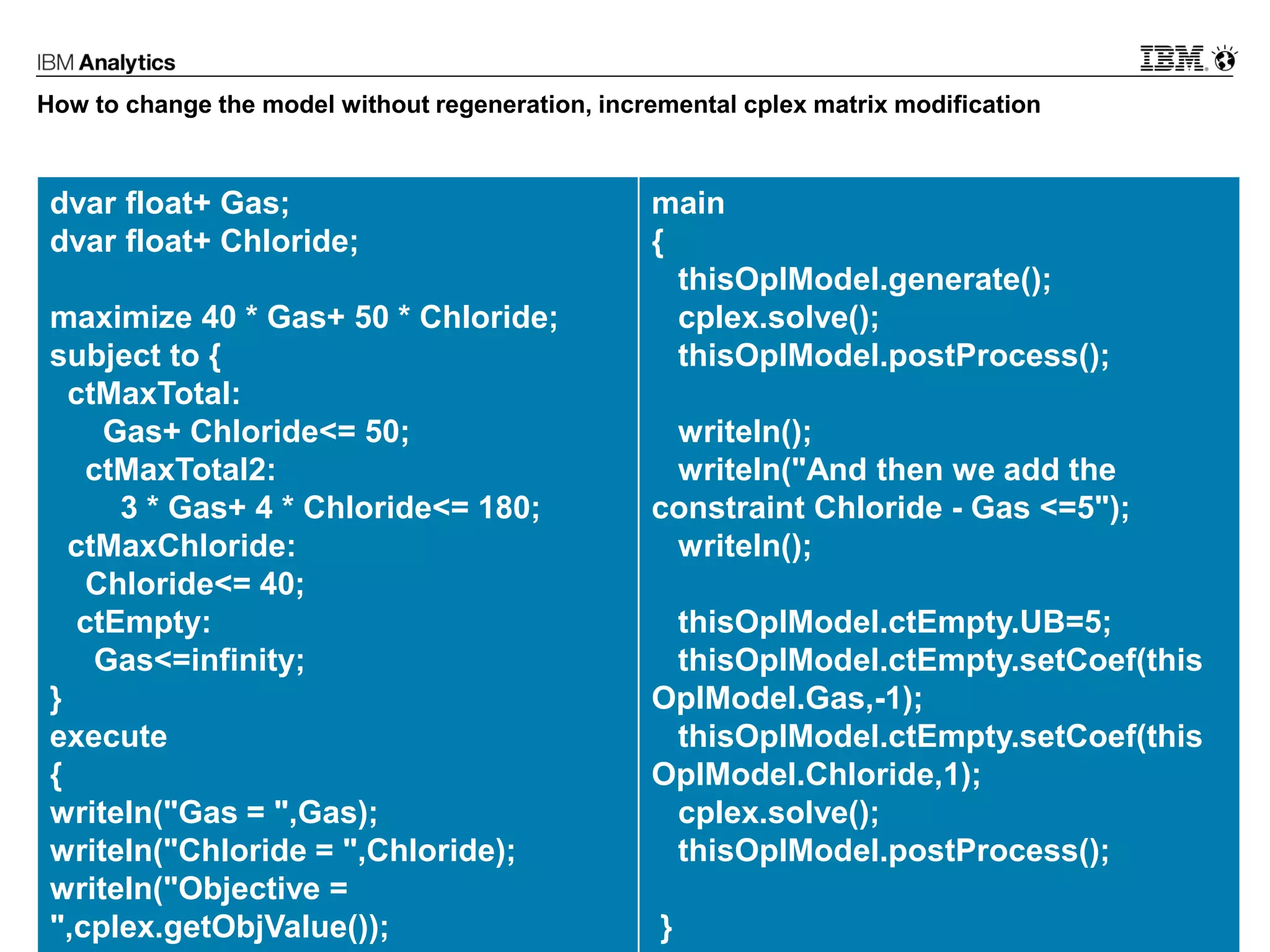

![© 2017 IBM Corporation26
How to solve the same model with different data ? Change an array and generate again
int y[1..2][1..2]=...;
execute
{
writeln("y=",y);
}
dvar float x;
maximize x;
subject to {
x<=sum(i in 1..2, j in 1..2) y[i][j];
}
int a[1..2][1..2];
main {
var source = new IloOplModelSource("sub.mod");
var cplex = new IloCplex();
var def = new IloOplModelDefinition(source);
for(var k=11;k<=15;k++)
{
var opl = new IloOplModel(def,cplex);
var data2= new IloOplDataElements();
data2.y=thisOplModel.a;
data2.y[1][1]=k;
opl.addDataSource(data2);
opl.generate();
if (cplex.solve()) {
writeln("OBJ = " + cplex.getObjValue());
} else {
writeln("No solution");
}
data2.end();
opl.end();
}
}](https://image.slidesharecdn.com/oplbestpractices-170718075121/75/OPL-best-practices-Doing-more-with-less-easier-26-2048.jpg)
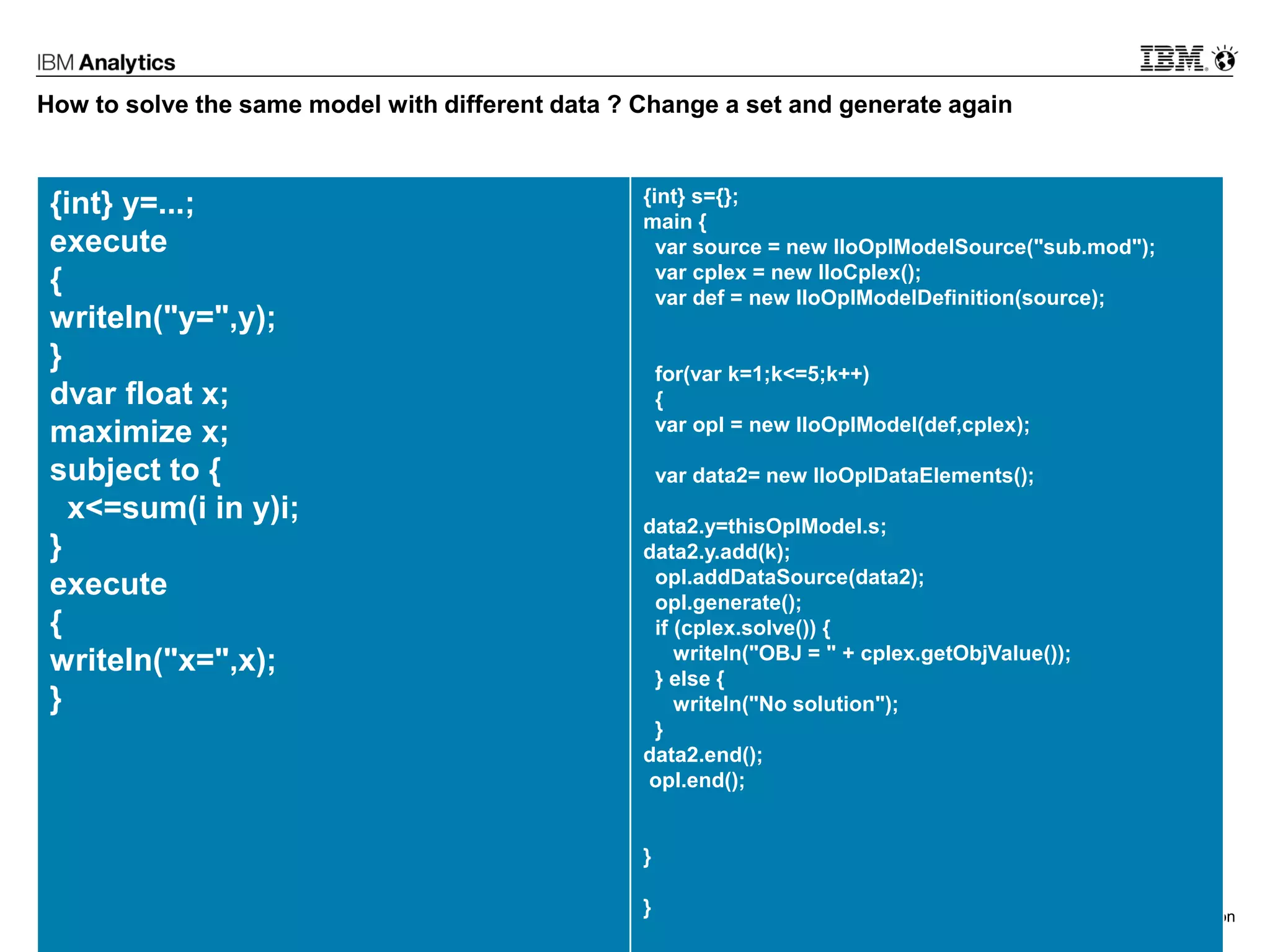
![© 2017 IBM Corporation28
Solve Anyway
int prefsolveanyway1[1..1]=[0];
int prefsolveanyway2[1..1]=[0];
int prefsolveanyway3[1..1]=[0];
int priority[1..3]=[1,2,3];
dvar int x;
dvar int y;
dvar int z;
subject to
{
0<=x<=20;
0<=y<=20;
0<=z<=20;
forall(i in 1..1) ct1:y-x>=7;
forall(i in 1..1) ct2:z-y>=9;
forall(i in 1..1) ct3:z-x<=10;
}
main {
function writeRelaxation(opl)
{
var iter = opl.relaxationIterator;
for(var c in iter)
{
var constraint=c.ct;
writeln(constraint.name);
writeln("LB = ",c.LB);
writeln("UB = ",c.UB);
writeln("relaxedLB = ",c.relaxedLB);
writeln("relaxedUB = ",c.relaxedUB);
}
}
thisOplModel.generate();
var def = thisOplModel.modelDefinition;
// Default behavior
writeln("Default Behavior");
writeln();
var cplex1 = new IloCplex();
var opl1 = new IloOplModel(def, cplex1);
opl1.settings.relaxationLevel=1;
writeln("Solve Anyway");
// Priority 1 : ct1
// Priority 2 : ct2
// Priority 3 : ct3
var currentPriority = 1;
var noSolution=1;
while (noSolution==1)
{
writeln();
var cplex2 = new IloCplex();
var opl2 = new IloOplModel(def, cplex2);
opl2.generate();
writeln("relaxing priority less than ",currentPriority) ;
if (opl2.priority[1]<=currentPriority) opl2.prefsolveanyway1[1]=1; else
opl2.prefsolveanyway1[1]=0;
if (opl2.priority[2]<=currentPriority) opl2.prefsolveanyway2[1]=1; else
opl2.prefsolveanyway2[1]=0;
if (opl2.priority[3]<=currentPriority) opl2.prefsolveanyway3[1]=1; else
opl2.prefsolveanyway3[1]=0;
opl2.relaxationIterator.attach(opl2.ct1, opl2.prefsolveanyway1);
opl2.relaxationIterator.attach(opl2.ct2, opl2.prefsolveanyway2);
opl2.relaxationIterator.attach(opl2.ct3, opl2.prefsolveanyway3);
writeRelaxation(opl2);
writeln("cplex status = ",cplex2.getCplexStatus());
if (cplex2.getCplexStatus()==14)
{
noSolution=0;
writeln("x,y,z = ",opl2.x," ",opl2.y," ",opl2.z);
}
currentPriority++;
}
opl2.end();
cplex2.end();](https://image.slidesharecdn.com/oplbestpractices-170718075121/75/OPL-best-practices-Doing-more-with-less-easier-28-2048.jpg)

![© 2017 IBM Corporation30
TSP with CPO
minimize endOf(itvs[n+1]) - (n+1);
subject to
{
startOf(itvs[1])==0; // break sym
noOverlap(seq,Dist,true); // nooverlap with a distance matrix
last(seq, itvs[n+1]); // last node
}
NB:
For big instances, CPLEX works better than CPO but as soon as you add side
constraints then CPO can tackle whereas CPLEX not always can
Plus CPO gives a solution any time wheras with CPLEX you need a flow
control to remove circuits.](https://image.slidesharecdn.com/oplbestpractices-170718075121/75/OPL-best-practices-Doing-more-with-less-easier-30-2048.jpg)
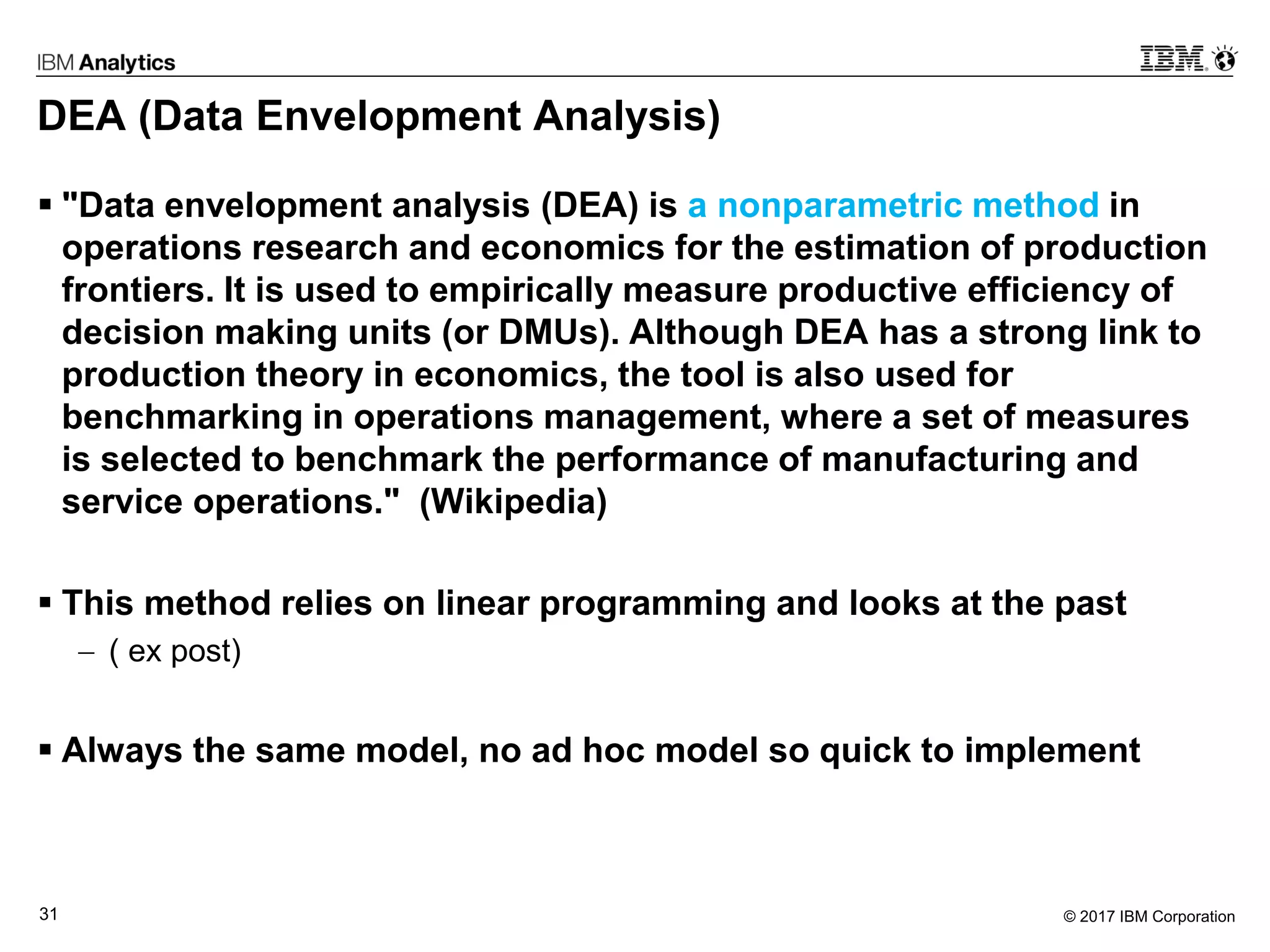
![© 2017 IBM Corporation32
Data Envelopment Analysis (DEA) in OPL
int nbDMU=...;
int nbInputs= ...;
int nbOutputs=...;
range DMU=1..nbDMU;
range Input=1..nbInputs;
range Output=1..nbOutputs;
// Input
float X[DMU][Input]=...;
// Output
float Y[DMU][Output]=...;
int refDMU=...; // We want to measure efficiency of that DMU
assert refDMU in DMU;
dvar float+ theta;
dvar float+ lambda[DMU];
minimize theta;
subject to
{
forall(j in Input)
ctInput:
sum(i in DMU) (lambda[i]*X[i][j]) <= theta*X[refDMU][j];
forall(j in Output)
ctOutput:
sum(i in DMU) (lambda[i]*Y[i][j]) >= Y[refDMU][j];
}
execute
{
writeln("theta= ",theta);
if (theta==1) writeln("Efficient DMU");
// Loop to measure efficiency for all
DMU
main
{
thisOplModel.generate();
for(var dmu in thisOplModel.DMU)
{
writeln("DMU",dmu);
for(j in thisOplModel.Input)
thisOplModel.ctInput[j].setCoef(thisO
plModel.theta,-
thisOplModel.X[dmu][j]);
for(j in thisOplModel.Output)
thisOplModel.ctOutput[j].LB=thisOplM
odel.Y[dmu][j];
cplex.solve();
thisOplModel.postProcess();
}](https://image.slidesharecdn.com/oplbestpractices-170718075121/75/OPL-best-practices-Doing-more-with-less-easier-32-2048.jpg)
![© 2017 IBM Corporation33
How to import docplexcloud solution into a local OPL session
from docloud.job import JobClient
client = JobClient(url, key)
// Run the model in docplexcloud
with open("model/diet.mod", "rb") as modFile:
resp = client.execute(input=[{"name":"diet.mod",
"file":modFile},
"model/diet.dat"],
output="results.json",
log="solver.log",
gzip=True,
waittime=300,
delete_on_completion=True)
// import the json result file
import json
with open('results.json') as data_file:
data = json.load(data_file)
// write that into a .dat
res = open("sol.dat", "w")
res.write("s={");
quote='"'
for i in data["s"]:
res.write("<"+quote+i["food"]+quote+
","
+quote+i["nutrient"]+quote+","+str(i["
value"])+",>")
res.write("};")
res.close()](https://image.slidesharecdn.com/oplbestpractices-170718075121/75/OPL-best-practices-Doing-more-with-less-easier-33-2048.jpg)
